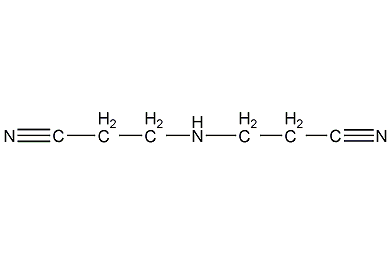
Structural formula
| Business number | 034P |
|---|---|
| Molecular formula | C6H9N3 |
| Molecular weight | 123.16 |
| label |
Bis(β-cyanoethyl)amine, β,β’-iminodipropionitrile, 3,3′-Iminodipropionitrile, β,β’-iminodipropionitrile, 3,3′-imine dipropionitrile, 3,3′-Iminodipropionitrile, 2,2′-Dicyano-diethylamin, Bis(2-cyanoethyl)amine, fiber dye |
Numbering system
CAS number:111-94-4
MDL number:MFCD00001956
EINECS number:203-922-3
RTECS number:UG2975000
BRN number:None
PubChem number:24859071
Physical property data
1. Properties: colorless liquid.
2. Density (g/mL, 30℃): 1.0165
3. Relative vapor density (g/mL, air=1): 3.3
4. Melting point (ºC): -5.5
5. Boiling point (ºC, 1.33kpa): 173
6. Boiling point (ºC, 5.2kPa): Undetermined
7. Refractive index: Undetermined
8. Flash point (ºC): >110
9. Specific rotation (º): Undetermined
10. Autoignition point or ignition temperature (ºC): Undetermined
11. Vapor pressure (mmHg, 25ºC): Undetermined
12. Saturated vapor pressure (kPa, 140ºC): 0.133
13. Heat of combustion (KJ/mol): Undetermined
14. Critical temperature (ºC): Undetermined
15. Critical Pressure (KPa): Undetermined
16. Log value of oil-water (octanol/water) distribution coefficient: Undetermined
17. Explosion upper limit (%, V/V): Undetermined
18. Lower explosion limit (%, V/V): Undetermined
19. Solubility: soluble in water, ethanol, acetone, benzene.
Toxicological data
1. Irritation: Rabbit transdermal: 500mg/24 hours, mild irritation. Rabbit eye: 500mg, severe irritation.
2. Acute toxicity: LD50: 2700 mg/kg (rat oral); 2500 mg/kg (rabbit transdermal)
Acute toxicity:
Oral LD50 >3200mg/kg(mus)
2700 mg/kg(rat)
Skin LD >10ml/kg(guinea pig)
LD50 2520ul /kg(rbt)
Inhalation LCLo/1H 4000ppm/1H(rat)
LCLo/6H 0.3mg/m3/6H(mus)
Irritate skin mild 500mg/ 24H(rbt)
Mild eye irritation 500mg/24H(rbt)
Severe 500mg(rbt)
Main irritating effects:
On skin: Irritation to skin and mucous membranes.
On eyes: Irritation effects
Sensitization: No known sensitizing effects.
Ecological data
This substance is harmful to the environment. Do not let this substance enter the environment. Special attention should be paid to the pollution of water bodies.
Molecular structure data
5. Molecular property data:
1. Molar refractive index: 33.26
2. Molar volume (cm3/mol): 123.1
3. Isotonic specific volume (90.2K): 315.4
4. Surface tension (dyne/cm): 43.0
5. Polarizability (10-24cm3): 13.18
Compute chemical data
1. Reference value for hydrophobic parameter calculation (XlogP): -0.8
2. Number of hydrogen bond donors: 1
3. Number of hydrogen bond acceptors: 3
p>
4. Number of rotatable chemical bonds: 4
5. Number of tautomers: none
6. Topological molecule polar surface area 59.6
7. Number of heavy atoms: 9
8. Surface charge: 0
9. Complexity: 126
10. Number of isotope atoms: 0
11. Determine the number of atomic stereocenters: 0
12. Uncertain number of atomic stereocenters: 0
13. Determine the number of chemical bond stereocenters: 0
14. Number of uncertain chemical bond stereocenters: 0
15. Number of covalent bond units: 1
Properties and stability
Avoid contact with strong oxidants and acids.
Storage method
Store in a cool, ventilated warehouse. Keep away from fire and heat sources. Protect from direct sunlight. Keep container tightly sealed. They should be stored separately from oxidants and acids, and avoid mixed storage. Equipped with the appropriate variety and quantity of fire equipment. The storage area should be equipped with emergency release equipment and suitable containment materials.
Synthesis method
None
Purpose
Used as gas chromatography stationary solution.

 微信扫一扫打赏
微信扫一扫打赏

